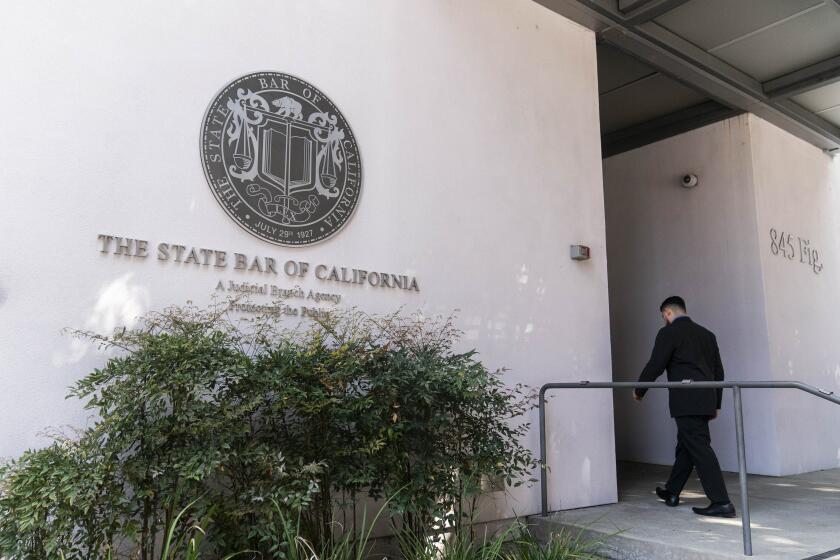Strained Delta Levees Watched as Storms Ease
- Share via
SAN FRANCISCO — Storms that claimed at least seven lives in Northern California eased off Wednesday and the forecast was for some sunny weather ahead, but levees along the Sacramento River Delta--threatened by a collapsed dam--were straining to contain rivers swollen by a week of torrential rains.
In Yuba City and Marysville, authorities considered evacuating all non-ambulatory patients from hospitals as the Feather River was only six inches from topping its levees.
Despite the threat in Sacramento County, a state Office of Emergency Services spokesman said Wednesday afternoon that the levee system containing the nearly full Sacramento and American rivers was “holding up just fine.”
Army Corps of Engineers spokesman Bill Prout said the next 24 hours would be “quite critical.” He said the levees in the delta were built “a long time ago” and in some cases, the materials would not meet modern standards.
However, Devere Davis of the state Flood Control Center said, “we don’t have any levees that have failed.”
There were levee breaks along two small tributaries, though, forcing hundreds in Sacramento County to flee to American Red Cross shelters or find other temporary housing. The Mokelumne River in the delta southwest of Sacramento broke through a levee Wednesday, flooding homes and farms near Walnut Grove. Another levee broke on Arcade Creek, just north of downtown Sacramento, prompting evacuation of about 1,200 people.
National Weather Service forecasters predicted some rain in the north over the next several days, but they do not expect anything like the storms that dumped up to 18 inches of rain on some Northern California counties last weekend.
Some Good Signs
In fact, the weather service said in a special statement Wednesday afternoon: “There are signs in the heavens and on the weather charts that the deluge is coming to an end for soggy Northern and Central California.”
Satellite pictures, the forecasters said, were showing “a relatively cloud-free stretch of ocean to the west.”
And, they added, a bulge of high pressure was beginning to develop offshore, which should shield the area from advancing storm systems.
Southern California’s picture also brightened, when a new frontal system weakened as it approached shore. Still, said the weather service, there was a 40% chance of rain here this morning that could average less than a third of an inch along the coast and up to an inch in the mountains and the Ventura County burn area.
Over the next few days, forecasters said, the jet stream that has brought storms to the Southland will begin to push north, leaving the way clear for warmer and sunnier weather by the weekend.
Although things were looking up throughout the state, Gov. George Deukmejian on Wednesday proclaimed emergencies in nine more Northern California counties because of the prolonged rainstorms that turned streams into rampaging rivers and hillsides into oozing, muddy deathtraps.
The counties added to the list so that the state can apply for such federal aid as low-interest loans and temporary housing were Glenn, Lake, Marin, Modoc, Sacramento, Santa Clara, Santa Cruz, Solano and Yuba. On Tuesday, the governor had proclaimed emergency states in Humboldt, Napa and Sonoma counties.
At least one lane of Interstate 80, the main freeway through the High Sierra from the Bay Area, was reopened near Truckee after a massive mud slide had shut it down earlier in the week. Interstate 5 south of Sacramento was shut because of flooding on the Mokelumne River.
Dry Ground
North of San Francisco, in hard-hit Sonoma, squadrons of Air National Guard troop-carrying and rescue helicopters plucked another 300 people from a sodden, battered mountain. After landing on dry ground, the evacuees were taken in buses to an evacuation center in downtown Sonoma.
The state Office of Emergency Services reported 8,376 people remained evacuated in Northern California, and said that nearly 2,000 homes and businesses had been damaged or destroyed since the storms began a week ago.
David Zocchetti, spokesman for the state office, also reported nine storm-related deaths and 41 injuries. A check of rain-stricken Northern California counties, however, brought confirmation of only seven storm deaths.
Authorities were paying particular attention to Folsom Dam, a major flood control structure on the American River, which flows through Sacramento and into the Sacramento River in the delta. Folsom Reservoir surpassed its capacity early in the week, in part because a temporary earthen dam above Auburn failed on Tuesday, while two smaller dams farther upstream were releasing large amounts of water to avoid overflowing.
Straight Flow
“There is just a straight flow down the north fork of the American River into Folsom Lake,” said Gerald Carroll, spokesman for the federal Bureau of Reclamation.
Of all the dams in California’s intricate flood control system, Folsom Dam “without a doubt . . . is the critical one,” Carroll said.
“We’ve never been in this situation before. . . . We are releasing more water into the American River than we ever have,” Carroll said, adding that this is “the first time that the levees (downstream) were being subjected to this much water.”
To prevent the dam from overflowing in an uncontrolled release, workers took the extraordinary step of completely raising the dam’s floodgates, a move that increased the reservoir’s capacity, but also meant that 130,000 cubic feet--or 910,000 gallons--per second of water was flowing out of the dam.
“It is creating a stress on the dam, but it is built to hold it,” Carroll said. “There are no signs of any cracking, seeping or leakage beyond what is normal.”
As heavy snow and rains continued in the Sierra Nevada, visitors were turned away from the entrance of Yosemite National Park, because of road flooding, rock slides and sodden campgrounds. California 140 between the entrance station and Yosemite Valley reportedly had as many as 10 slides with a foot of water across the road in numerous places.
The campgrounds will remain closed at least through Friday, said spokeswoman Mallory Smith.
At Mammoth Mountain, snow depth was 174 inches. Winds up to 100 m.p.h. were clocked at the summit during the morning.
Southern California’s sunny respite began after an early morning drenching that measured 1.08 inches at the Los Angeles Civic Center, bringing the season’s total to a respectable 12.13 inches. The normal season total to date is 10.21 inches.
The rain, which began between 3 and 4 a.m., was tapering off by midmorning and it was not long before the basin was basking in pale sunlight. Wednesday’s Los Angeles Civic Center high was 69 degrees, after an overnight low of 60.
New Problems
The Wednesday morning rains did not produce many new problems, other than to snarl some traffic, clog the freeways and set off some rock slides that closed Malibu Canyon Road for a time. Pacific Coast Highway and Topanga Canyon Boulevard remained open, though, as highway crews kept grading equipment busy.
Los Angeles International Airport reported flight delays of up to 40 minutes, with flights taking off eastward rather than westward over the ocean because of rain and decreased visibility. Worse weather in Northern California and elsewhere also contributed to the delays, an airport spokeswoman said.
There were no new major mud slides or flooding reported in Ventura County, where residents of last summer’s brush fire areas have been dreading a possible disaster.
By early afternoon, Ventura County Sheriff’s Lt. Ernie Rogers said happily, “The sun is shining. The next rain was supposed to be here by now, but it’s not.”
In the Matilija Dam area above Ojai, where two houses were destroyed by mud slides over the weekend, some residents still were unable to return to their homes because of slides blocking the road. The Ventura County Flood Control District had measured 2.54 inches of rain in the 24 hours up to 8 a.m. Wednesday.
Dan Morain reported from San Francisco; Jack Jones from Los Angeles. Times staff writers Ruth Snyder in San Francisco and Kenneth Bunting and Richard C. Paddock in Sacramento, also contributed to this article.
More to Read
Sign up for Essential California
The most important California stories and recommendations in your inbox every morning.
You may occasionally receive promotional content from the Los Angeles Times.










